Garganelli – Maccheroni al Pettine
Emilia-Romagna is the home of world famous sfoglia, rich fresh egg pasta rolled paper thin. From that divine pasta comes garganelli.
Ridged tubes of pasta formed from a square of pasta rolled around a bastoncino (stick), and passed over a ridged tool known as a comb or pettine (PEH-tee-nay), garganelli are one of my favorites, both to eat and to make.
Until recently the traditional implement used to make garganelli, the pettine (comb), was impossible to find in America, but once again Terry Mirri of Artisanal Pasta Tools has stepped up to the proverbial plate with two completely handmade versions. His combs come with 4 different sizes of dowels for forming the garganelli. This dowel, or stick, is known as a bastoncino (bass-tone-CHEE-noh.)
A note; if you come across a small ridged rectangular board, about 2 ½ X 4 3/4 inches with a bastoncino attached, say Eureka. Often marketed as a gnocchi board, it is in fact a mini pettine. As shown here, these tools are often set into a larger board with a hole for hanging on a wall.
The story goes that in 1725 the cook of Cardinal Cornelio Bentivoglio d’Aragona ran out of filling for her stuffed pasta. The broth was ready, but whether a pesky creature consumed the meat filling or whether extra guests arrived, the result was the same – more pasta than filling. Resourceful and clever, she made the best of the situation and worked with what she had. The cook borrowed a weaver’s tool, gathered some twigs, picked up her squares of dough and went to work. She wrapped the dough around the twigs, rolled it over the weaving implement, and garganelli entered the Pantheon of Pasta. Necessity is the Mother of Invention.
The name itself comes to us from the Latin word for trachea, gargala. The ribs on a single garganello (when are you EVER going to use that word again!) span the circumference of the pasta, like the rings of cartilage in your throat. Honest, that is how this pasta got its name. Funny, but this little bit of pasta trivia has popped up everywhere over the last two years. Prior to that, one had to dine with a Latin scholar or an anatomist for that little bit of enlightenment.
And don’t confuse this pasta with penne rigate. Garganelli, because they are hand rolled from a square of dough, have a seam. Penne, both lisce (smooth) and rigate (furrowed), are extruded and thus have no seam. Garganelli are made with eggs, and often enriched with nutmeg and Parmigiano. Penne are made from flour and water. Poor penne. Lastly the ridges on garganelli run a circuit around the body of the pasta, while on penne rigate, they run the length of the pasta. No need to be confused. Consider garganelli penne rigate’s wealthy cousin. Made by hand, this pasta reaps the benefit of the textures of the tools used to make it; the wooden counter and rolling pins and the pettine itself impart a rough surface that holds condimenti better than the smooth surface of machine made pasta.
Garganelli con asparagi e nocciole
Garganelli with Asparagus and Hazelnuts
serves 4 to 6
Traditionally garganelli are served with a hearty ragu. But I love them with a light sauce and Spring vegetables. So right now is Garganelli season in our house. If you have no tiny young asparagus, you may substitute 1 cup of young peas.
Pasta
1 3/4 cups 00 flour
1/4 cup semolina
1/4 teaspoon kosher salt
1/4 teaspoon freshly grated nutmeg
1/3 cup grated Parmigiano Reggiano
3 large eggs plus 1 egg yolk
extra flour and semolina for forming garganelli
Sauce
1/3 cup finely diced red onion
1 pound young asparagus, trimmed and cut in 2 inch pieces
1/2 cup hazelnuts, toasted and skinned, coarsely chopped
5-6 ounces Gorgonzola dolce
1/3 cup chopped Italian parsley or basil, or a combination
1/3 cup fruity olive oil
salt and pepper
Parmigiano to serve at the table
Make the pasta
Place flour, semolina, salt and nutmeg in workbowl of food processor fitted with metal blade. Pulse to combine.
Lightly beat eggs and Parmigiano in 1 cup measuring cup. With processor running, pour egg mixture through feed tube. Process until mixture comes together. If mixture is too wet, add flour a tablespoon at a time until mixture comes together.
Remove from processor. Knead several minutes on floured board.
Form into disk, and wrap in plastic. Set aside to rest 30 minutes to 1 hour.
How to blanch asparagus
Rinse asparagus and break off ends. Slice in 2 inch lengths. Drop in large pot of heavily salted boiling water for 1 to 2 minutes. Remove to ice water to shock and stop cooking. Drain and dry. Wrap in plastic and refrigerate. This step may be done 1 day ahead.
How to toast and skin hazelnuts
Toasting hazelnuts amplifies their natural favor. And since the skin can be bitter, removing as much of it as you can is a must. Preheat oven to 325 degrees. Place nuts on rimmed baking sheet and toast on center rack of oven 10 to 12 minutes, stirring once or twice. Remove from oven and transfer nuts to rough kitchen towel. Rub nuts together in towel to remove as much of the skin as possible. Some of the skin will be quite tenacious; don’t worry if you can not remove all of it. Shoot for about half to three quarters. This may be done days ahead. If you are not using the nuts that day, store them, as with all nuts, in the freezer.
How to make garganelli
Work with a quarter of the dough at a time, keeping the remainder wrapped.
Roll dough by hand or using a pasta machine to 1/16th inch thick.
On lightly floured board, cut dough into 2 X 2 inch squares.
Place 1 square of dough on floured pettine with one of the corners pointing toward you.
Place floured bastoncino on square of dough and roll pasta around it.
Maintaining firm pressure, roll dough around bastoncino forming a tube and imprinting ridges. Be certain the tip is sealed.
Slip garganello off bastoncino and place on semolina lined towel. Cover until ready to cook.
Make the sauce
Cook garganelli 1 to 2 minutes in large pot of well salted boiling water. Drain pasta and reserve water.
As pasta water finishes coming to the boil, heat oil in large saute pan over medium heat. Add onion and cook briefly to soften but not color, about 2 minutes. Add blanched asparagus, and cook another minute or two. Add 1/4 cup pasta water and hazelnuts. Cook until water is almost evaporated. Add cooked pasta and stir until coated. Remove from heat and add Gorgonzola and herbs, stirring until pasta and vegetables are well coated and cheese is almost completely melted. Season with salt and pepper, adding bit more pasta water if pasta appears too tight. Serve at once. Pass Parmigiano at the table.
Note: You can click on any picture for a larger image, and to see a slide show!
I have no affiliation with any product, manufacturer, or site mentioned in this article.
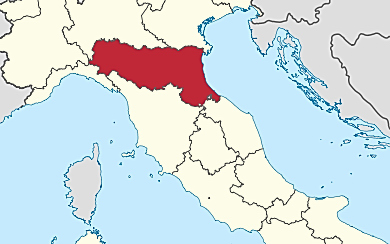
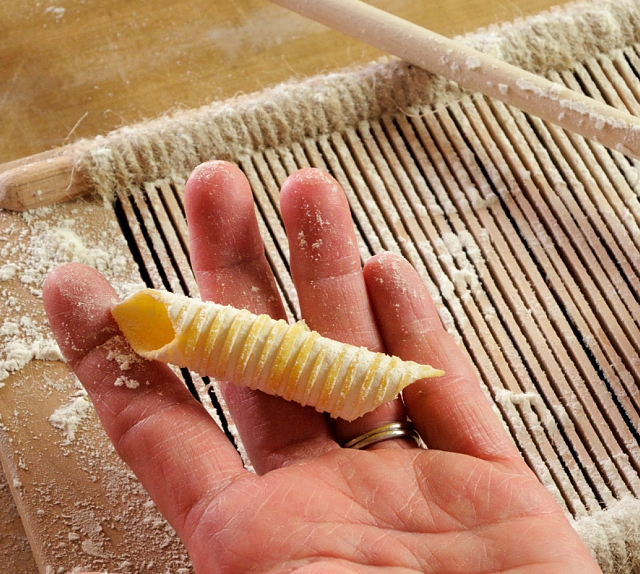

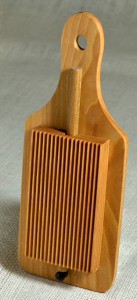


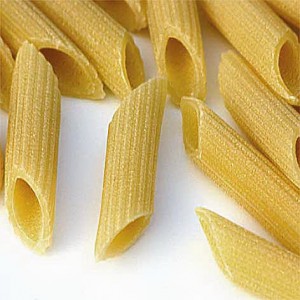
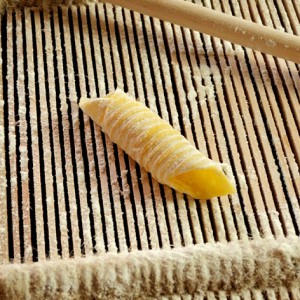
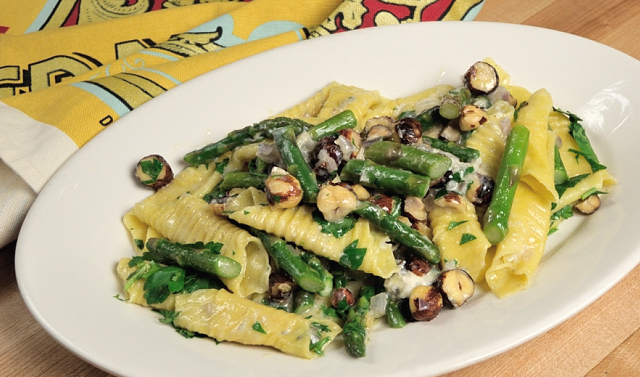
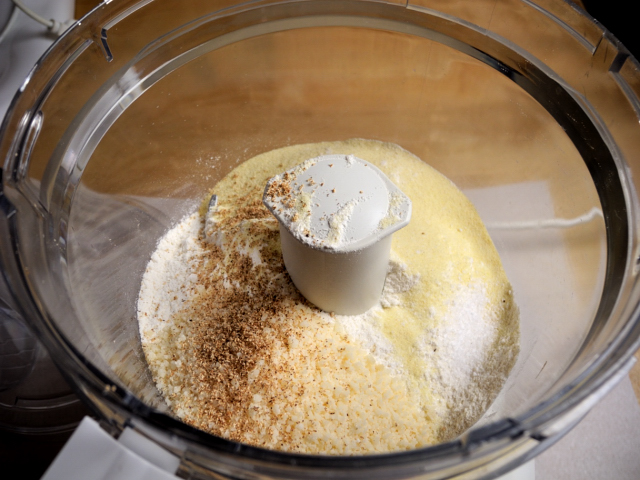
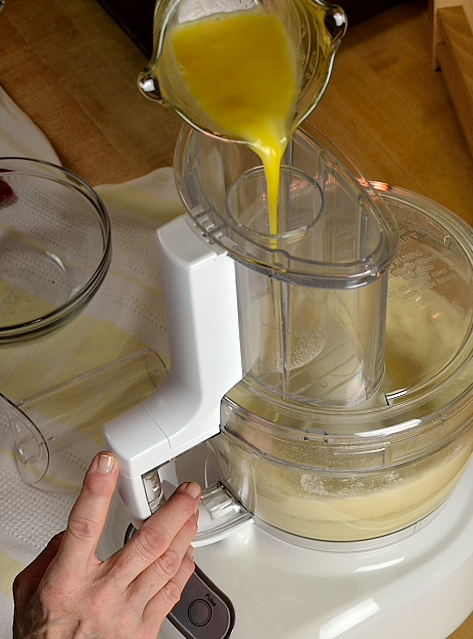
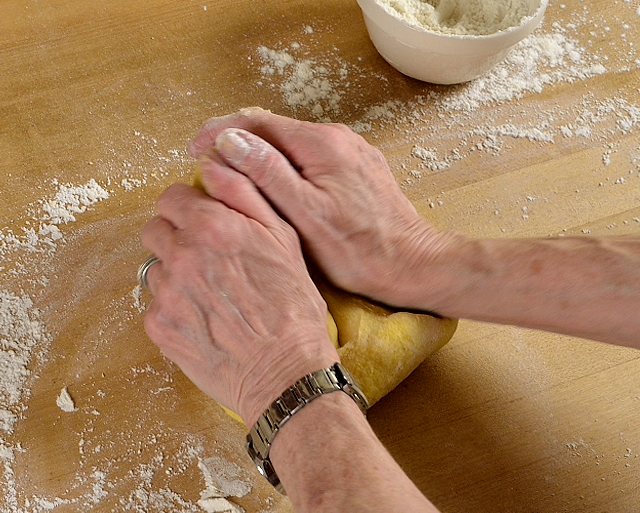

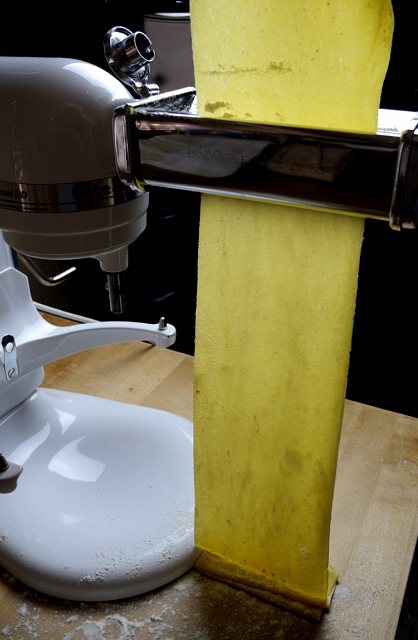
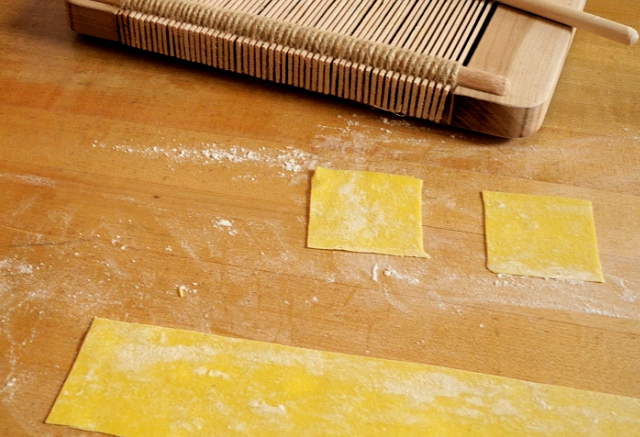
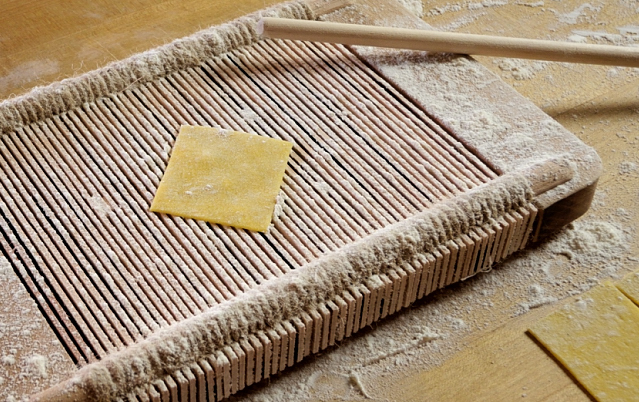
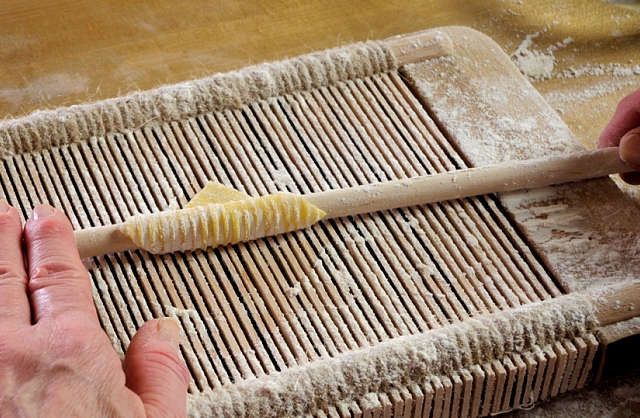
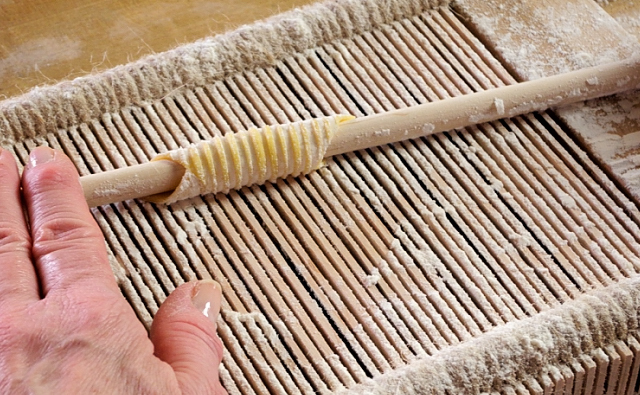
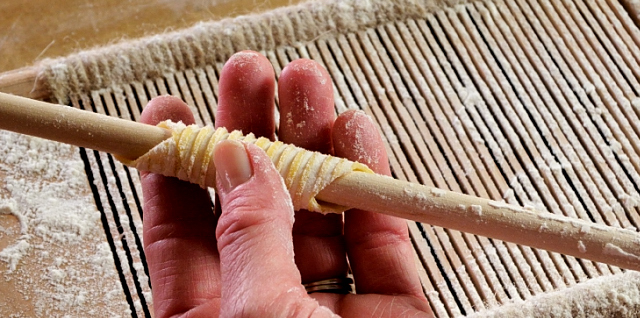

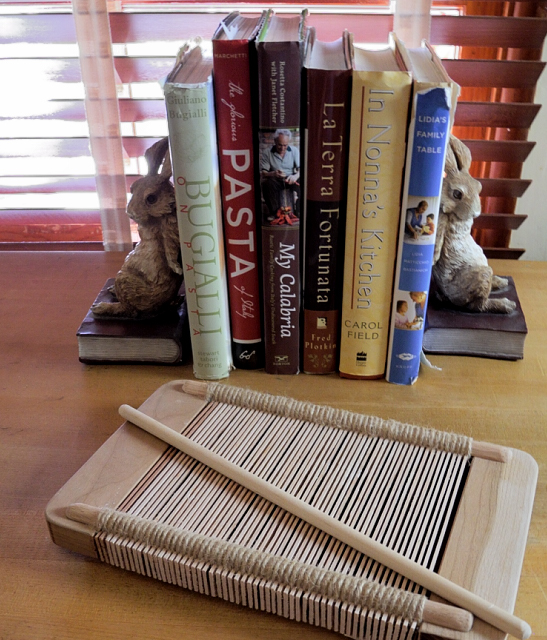

Friday, April 13th 2012 at 10:13 pm |
Thats so funny, I just saw a small pettine at Sur laTable, thinking what a fancy gnocchi board. Now I wish I had bought it! I’m thinking maybe a bamboo sushi mat might work in a pinch?
Saturday, April 14th 2012 at 7:15 am |
Benvenuto!
I never thought of a sushi mat, but it might work, although I do not think you will get very deep ridges. Amazingly enough what does work is a very large tooth comb and a pencil. Honest! The process is easiest and quickest with the dedicated tool, but like Cardinal Cornelio’s cook, why not do with what you have! Next time you are Sur la Table, grab a pettine. They are quite inexpensive. Sur la Table asks $9.95.
To preserve my small one and keep the wood from drying and cracking, I rub it with block oil. The oil has the added benefit of deepening and enhancing the tone of the wood. And as with many wooden kitchen implements, do not immerse it in water, just give it a good once over with a small brush to clean. I hope you try making garganelli. It really is fun. And when you make them, send me a photo for my Readers’ Gallery. I would love to display your work! Thanks for stopping by my site. I hope you return often.
Saturday, April 14th 2012 at 8:12 am |
the finished dish looks wonderful! I love the story too!
Saturday, April 14th 2012 at 9:53 am |
Thanks Bree!
I am so glad you like it. I enjoy making it, and the process goes very quickly once you get a rhythm going. They are good with lots of different doughs. One of my faves is to use spinach pasta dough – the same one I use for my corzetti. Perhaps it is time for a family garganelli making fest. What do you think?
Saturday, April 14th 2012 at 8:43 pm |
Just reading the recipe made me hungry And the photo is mouth watering
Saturday, April 14th 2012 at 11:36 pm |
Ciao Anthony,
It is good to hear you like this one. The asparagus and hazelnuts are a nice match for the Gorgonzola dolce and pasta. Give this one a try for a light Springtime pasta. I bet you will like it. Thanks for visiting and thanks especially for your comment.
Sunday, April 15th 2012 at 6:38 am |
Adri– I just love your pasta-making posts. They are incredible. All the history of it is so interesting to me. I like the fact that the Cardinal’s cook was a woman. If it had been a man, would he have thought of using a weaving implement or would he have used a rake? I love the antique tools and the lovely Italian names both familiar and unfamiliar– “garganello” “pettine” “bastoncino” . Americans often say with wonder that the Chinese have 100 different words for rice, I am guessing that the Italians could give them a run for their money on words for pasta. You just gave me a new one “garganello”. Thank you!!
Sunday, April 15th 2012 at 8:12 am |
Hi Trisha,
I am pleased to hear you enjoy the pasta posts. I absolutely enjoy doing them, and what always amazes me is that I learn something new every time I work on one, especially the ones with the step-by-step directions and tutorials. It is always gratifying to hear that people find them of interest. I never know just how much info to include. In my attempts to avoid boring people I find myself removing entire swaths of my first writing. Bart and I are what some of our friends call Infomaniacs; our home is choc-a-block with books, periodicals and other printed matter, a good deal of which treats all matters culinary. From my vantage point one can never have too much info.
I hope you try this one. Do you think your teens would enjoy this as a family dinner project? Or would they do that teen thing where they roll their eyes while intoning “Mom,” somehow managing to make “Mom” sound as though it has twenty syllables? It seems like it could be a blast if the kids were up for it. Also projects such as this are much more fun and many more laughs if you have a group of people working together. I am always amazed at how much pasta three of four people can make.
Thanks for stopping by, and let me know how it goes in the kitchen!
Monday, April 16th 2012 at 12:07 pm |
Looks sooooo delicious
Monday, April 16th 2012 at 1:19 pm |
Hi Peggy,
I love hearing from readers. I enjoy the feedback, and I appreciate the time people take to stop and write. I hope you make some garganelli. They are really simple once you get going, and people always enjoy them. Thank you for visiting. I hope you stop by often.
Monday, April 16th 2012 at 12:52 pm |
Adri ~ your pasta posts are wonderful. Thank you for yet another one. By the way, you are the one that introduced me to those products at Artisanal Pasta Tools. They are an excellent resource. grazie!
Monday, April 16th 2012 at 1:59 pm |
Hi Domenica,
Thank you so much for your kind words. I am truly flattered to hear you enjoy my pasta posts. I enjoy doing them, and this is one I have meant to do for ages. I looked back and I had actually begun making notes over one year ago. Wow, did I ever get sidetracked. It is a good thing garganelli are timeless!
I am so pleased you like the tools Terry makes. They are works of art whose beauty is enhanced by their functionality. Like us, Terry is proud of his Italian heritage, and he is very serious about continuing Italy’s culinary traditions. Through the purchase and use of his tools we are ensuring that these foods will remain a living part of Italian-American food culture.
Monday, April 16th 2012 at 6:38 pm |
I love everything about this post – the photos are beautiful, the history of the pasta, the step-by-step instruction and the great sauce. I can’t wait to try making these but I want to get one of those old-fashioned pettine.
Monday, April 16th 2012 at 7:21 pm |
Hi Linda,
Oh thank you! I am so glad this post has inspired you to find an old fashioned pettine. Terry at Artisanal Pasta Tools will happily fabricate one for you if you decide not to wait for your return to Italy. I will wager that you’ll find making garganelli an absolute snap after having made those gorgeous Tortelli Piacentini. I look forward to hearing from you once you have found a pettine. I am so pleased that you stopped by My site.
Friday, April 27th 2012 at 10:06 pm |
Un post molto interessante, devo procurarmi l’attrezzo per fare i garganelli,mi piace molto la ricetta, anche io amo aggiungere la frutta secca nei primi, trovo che dia una marcia in più ! Complimenti per il tuo blog! Buon weekend…
Saturday, April 28th 2012 at 7:04 am |
Grazie! E complimenti per il tuo blog. E meraviglioso!
Monday, May 13th 2013 at 2:54 pm |
Grazie Mille per il suo “post” sul Gargnelli.
BTW, isn’t Terry Meri from Artisianal pasta tools the best? Of all of his tools I think his “pettine” may be the best. I just ordered one for firends who I will be visiting in Italy — an Italo American guy, making Italian pasta tools for italiani!
I made Garganelli di Ortica on Saturday (Nettle Garganelli). Made the traditional panna & prosciutto cotto sauce. Buonisimo….
One issue is some of mine keep their shape, others collapse a bit (but taste great). I think I need to use more semolina (I see you have Glorious Pasta, and I use her food processor method too, although she suggests only a tablesppon of semolina — I think Garganelli need more.) And while you say 1/16 an inch, is that the last or second to last on your KitcheAid? One sometimes here’s garganelli should be thicker, but with Pasta for me, like the saying goes, “you can never be too rich or too thin…”
Monday, May 13th 2013 at 10:27 pm |
Benvenuto Ray,
Thank you for your thoughts. First, Terry most certainly does rock my pasta world. It is such a joy to use his tools, and to be part of the continued thread of tradition is a wonderful thing. The garganelli post was my pleasure entirely. Sometimes my garganelli collapse also. Sometimes not. Although it in no way affects the flavor, I like it better when they retain an open shape. A little more semolina helps with that, but one starts to lose the delicacy as soon as one ups the semolina. The more delicate the better, as far as I am concerned, however the thinness and delicacy do leave the gargaenllie more prone to collapse. I go no further than the next to the last on my KitchenAid roller. Have you tried my spinach garganelli? Take a look at the article. They are great, and seem never to collapse. Just be certain to really wring the spinach as dry as you possibly can. Frozen spinach ought to lose about half its weight in water. Give them a go, and I would love to hear from you. Again, thanks so much for stopping by, and it is a pleasure to meet another fan of Terry’s work.
Monday, October 20th 2014 at 12:04 pm |
I love your website. Thank you for publishing an article on the garganelli board and the making of garganelli. I looked on Amazon, and the garganelli boards do not appear as traditional as the one posted in your article. Does anyone know where I can purchase an affordable, yet traditional, garganelli board?
Also, what is the best way to clean these garganelli boards with strings so as to remove all bacteria yet not damage or deteriorate the string?
Again, many, many thanks.
Carole Brighenti
Monday, October 20th 2014 at 6:30 pm |
Benvenuta Carole,
Thank you so much for visiting my site and for the kind words. You can purchase a small wooden board, such as the one pictured, at Amazon.com. Many stores call it a gnocchi board, although, in fact, it is a garganelli board – the little stick is the giveaway about its being a garganelli board. While this style of tool is not made of jute, it is used by housewives across Italy, and could absolutely be called “authentic.” As for cleaning tools made of both jute and wood, salmonella (since these are egg doughs) and other food borne bacteria are indeed a concern. However, immersing these tools in water and harsh detergents will ruin them. Should you get the wooden board wet (the style from Amazon) you can use some block oil to recondition it. Boos makes a nice oil and cream. This holds true, by the way, for your rolling pin. Don’t immerse it or get it wet. It is not good for the wood, but some oil will bring it back to life. As with my pasta maker, I dust the garganelli board off, and use a brush to remove any chunks of tenacious dough, and then I air dry it. I have used these tools for close to forty years, and have had no trouble with food poisoning. Again, thank you for stopping by, and for more on garganelli, see my post “Make you Own Spinach Garganelli.” Alla prossima!